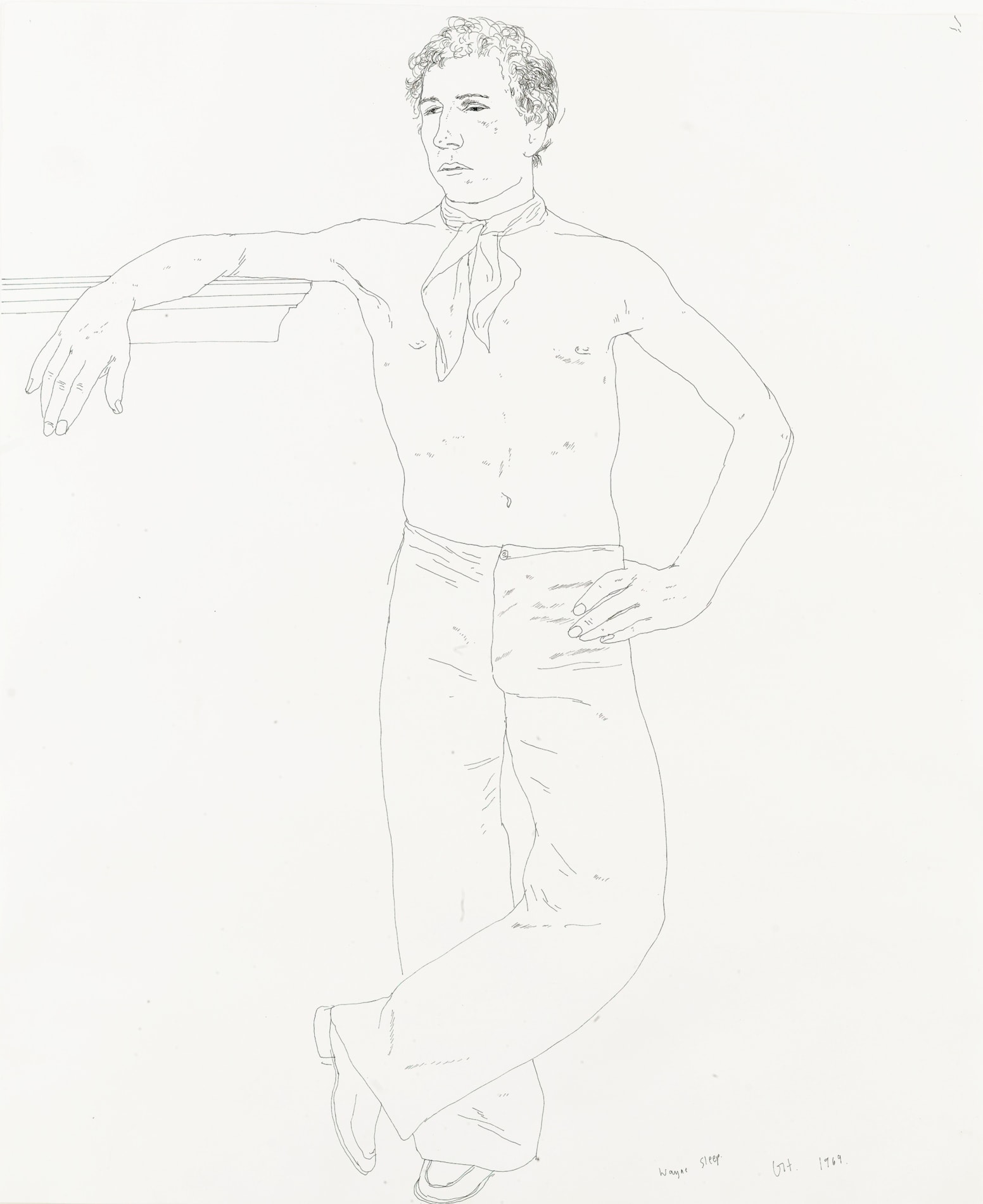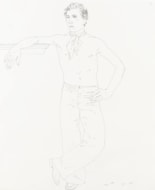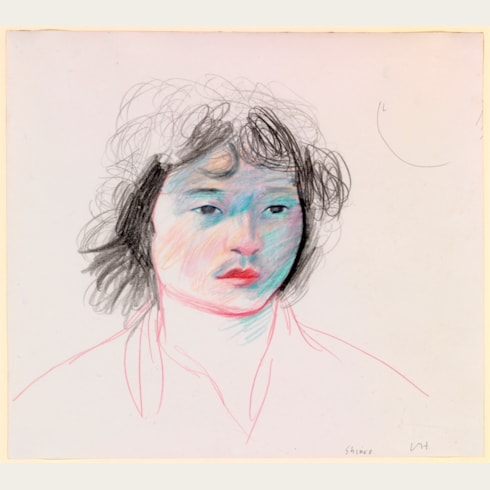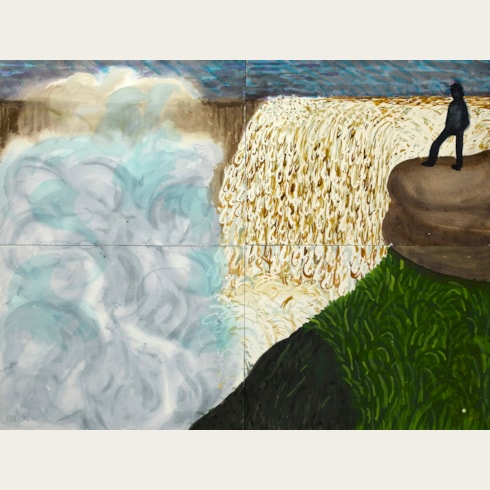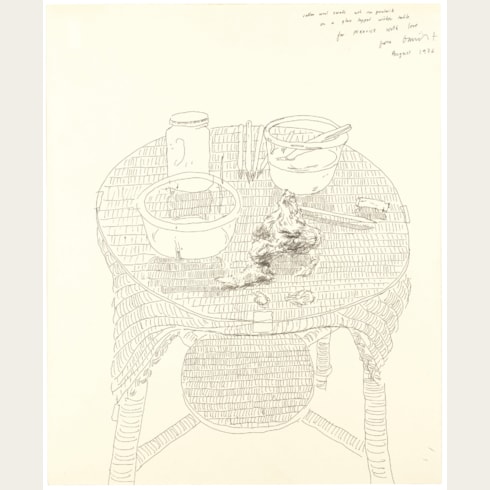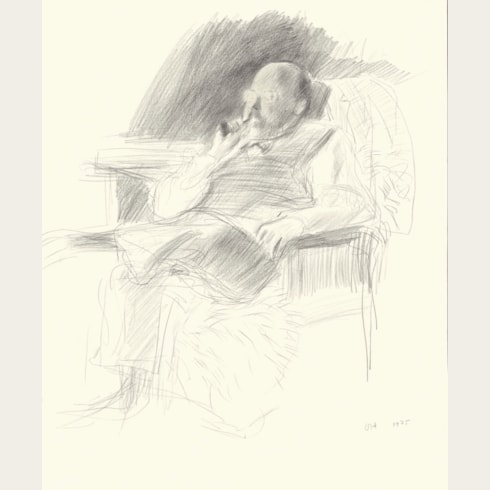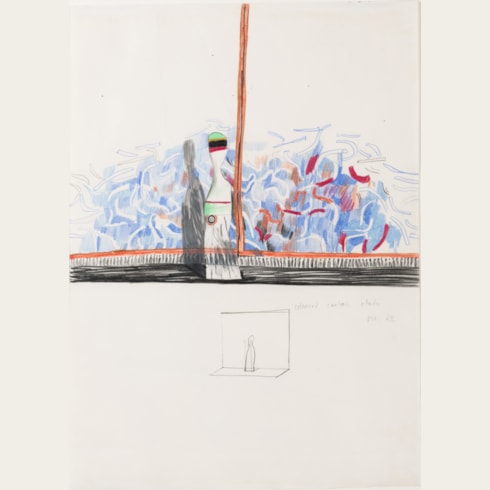David HOCKNEY
(Bradford Born 1937)
Wayne Sleep
Sold
Black ink on paper.
Inscribed, signed with initials and dated Wayne Sleep DH. 1969 at the lower right.
430 x 354 mm. (16 7/8 x 13 7/8 in.)
Inscribed, signed with initials and dated Wayne Sleep DH. 1969 at the lower right.
430 x 354 mm. (16 7/8 x 13 7/8 in.)
A splendid example of what are among Hockney’s most celebrated works, his pen and ink line portrait drawings, this is a portrait of the dancer Wayne Sleep (b.1948), who has modelled for the artist on several occasions. A principal dancer at the Royal Ballet, Sleep first met Hockney in 1967, a year after joining the company. The two were introduced by Lindy Dufferin, who had arranged for the artist to draw Rudolf Nureyev at the rehearsal studios of the Royal Ballet. Hockney and Sleep became good friends, and the artist was responsible for introducing Sleep to George Lawson, with whom he has since had a long relationship.
Despite the apparent facility with which these drawings are produced, the difficulty in defining a pose and likeness through outline alone, without tonal washes or shading, should not be underestimated. As the artist himself noted, ‘I never talk when I’m drawing a person, especially if I am making line drawings. I prefer there to be no noise at all so I can concentrate more. You can’t make a line too slowly, you have to go at a certain speed; so the concentration needed is quite strong. It’s very tiring as well. If you make two or three line drawings, it’s very tiring in the head, because you have to do it all at one go, something you’ve no need to do with pencil drawing; that doesn’t have to be done in one go; you can stop, you can rub out. With line drawings, you don’t want to do that. You can’t rub out line, mustn’t do it. It’s exciting doing it, and I think it’s harder than anything else; so when they succeed, they’re much better drawings, often. The failure rate amongst my line drawings is still high; I’m always tearing them up and putting crosses through them, because you can’t touch them up. If you draw the leg all wrong, you just have to throw it away.’
Between 1972 and 1975 Hockney worked on a large painting of Wayne Sleep and George Lawson, which he eventually abandoned. Set in Lawson’s London mews house, the painting showed him seated at a clavichord with Sleep standing in a doorway, listening to him playing. As Lawson recently recalled, ‘The pose was interesting...Wayne was looking at me at the keyboard, standing and listening. I think it was nice conceit that he had a ballet dancer not moving just listening.’4 However, Hockney soon found himself struggling with the painting. As he noted at the time, ‘in 1972, I began the painting of George Lawson and Wayne Sleep. Six months I worked on it, altering it, repainting it many times. It is documented, in its various stages. I kept taking photographs, thinking it was finished myself, and then deciding, it’s not right, no, that’s not right…I had a real struggle with it. Looking back now, two years later, I can see that the struggle was about naturalism, acrylic paint; it’s why I later abandoned acrylic paint and began to move away from naturalism.’
The present sheet, though drawn a few years earlier in 1969, is related to this unfinished painting in the pose of Sleep, who is shown standing with his legs crossed in the same way as in the drawing. Hockney may have referred to the present sheet when he came to develop the pose of Sleep in the painting.
Despite the apparent facility with which these drawings are produced, the difficulty in defining a pose and likeness through outline alone, without tonal washes or shading, should not be underestimated. As the artist himself noted, ‘I never talk when I’m drawing a person, especially if I am making line drawings. I prefer there to be no noise at all so I can concentrate more. You can’t make a line too slowly, you have to go at a certain speed; so the concentration needed is quite strong. It’s very tiring as well. If you make two or three line drawings, it’s very tiring in the head, because you have to do it all at one go, something you’ve no need to do with pencil drawing; that doesn’t have to be done in one go; you can stop, you can rub out. With line drawings, you don’t want to do that. You can’t rub out line, mustn’t do it. It’s exciting doing it, and I think it’s harder than anything else; so when they succeed, they’re much better drawings, often. The failure rate amongst my line drawings is still high; I’m always tearing them up and putting crosses through them, because you can’t touch them up. If you draw the leg all wrong, you just have to throw it away.’
Between 1972 and 1975 Hockney worked on a large painting of Wayne Sleep and George Lawson, which he eventually abandoned. Set in Lawson’s London mews house, the painting showed him seated at a clavichord with Sleep standing in a doorway, listening to him playing. As Lawson recently recalled, ‘The pose was interesting...Wayne was looking at me at the keyboard, standing and listening. I think it was nice conceit that he had a ballet dancer not moving just listening.’4 However, Hockney soon found himself struggling with the painting. As he noted at the time, ‘in 1972, I began the painting of George Lawson and Wayne Sleep. Six months I worked on it, altering it, repainting it many times. It is documented, in its various stages. I kept taking photographs, thinking it was finished myself, and then deciding, it’s not right, no, that’s not right…I had a real struggle with it. Looking back now, two years later, I can see that the struggle was about naturalism, acrylic paint; it’s why I later abandoned acrylic paint and began to move away from naturalism.’
The present sheet, though drawn a few years earlier in 1969, is related to this unfinished painting in the pose of Sleep, who is shown standing with his legs crossed in the same way as in the drawing. Hockney may have referred to the present sheet when he came to develop the pose of Sleep in the painting.
Although David Hockney made his first portraits and self-portraits as a teenager, it was not until the mid-1960’s that he began to seriously apply himself to portraiture, inspired by a new relationship with a young lover, Peter Schlesinger. Since that time, he has continued to produce portraits in the form of paintings, drawings, prints and photographs throughout his long and successful career. Portraiture has, indeed, been a central theme in much of his work. His sitters, with few exceptions, have been made up of friends, family, and lovers; people whom he knew well, and with whom he felt comfortable. As he himself has noted, ‘Naturally I’ve always liked drawing people, so one tends to draw one’s friends and the people one knows around you – anybody does…I think the way I draw, the more I know and react to people, the more interesting the drawings will be. I don’t really like struggling for a likeness. It seems a bit of a waste of effort, in a sense, just doing that. And you’d never know, anyway. If you don’t know the person, you don’t really know if you’ve got a likeness at all. You can’t really see everything in the face. I think it takes quite a lot of time.’ As a recent scholar has written, ‘the intensity of drawing meant that Hockney tended only to make portraits of friends who were sufficiently patient and understanding, and with whom he was sufficiently familiar to be able to capture the changes and variation in their appearance.’
Hockney’s portraits have been executed in almost every medium in which he has worked, including oil paint and acrylic, pencil, pen and ink, charcoal, coloured crayons, pastel and, more recently, watercolour, as well as in the form of etchings, lithographs, Polaroid photographs and photographic collages. Whatever the medium or technique, however, Hockney’s portraiture is invariably characterized by the artist’s close observation of his subject. As Marco Livingstone has noted, ‘All of the artist’s portrait drawings were made in the presence of the sitter, for in Hockney’s view a portrait by definition has to be done from life or very soon after. This, however, by no means excludes the possibility of incorporating elements from memory, since previous knowledge of how someone behaves or looks can alter one’s apprehension of that person on a later occasion. Hockney is convinced that having recourse to information gathered from past experience, in conjunction with the evidence of the moment, has allowed him to make livelier and more animated faces than might otherwise have been possible.’
Provenance
Gene Baro, Old Bennington, Vermont
Private collection
Anonymous sale, Boston, Skinner, 19 May 2006, lot 456
Anonymous sale, London, Christie’s, 17 November 2006, lot 120
Agnew’s, London, in 2007.

